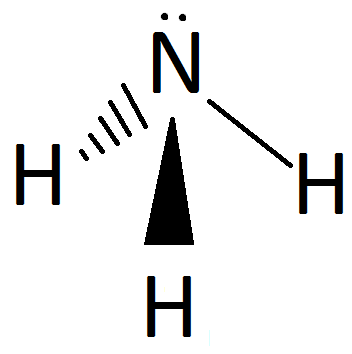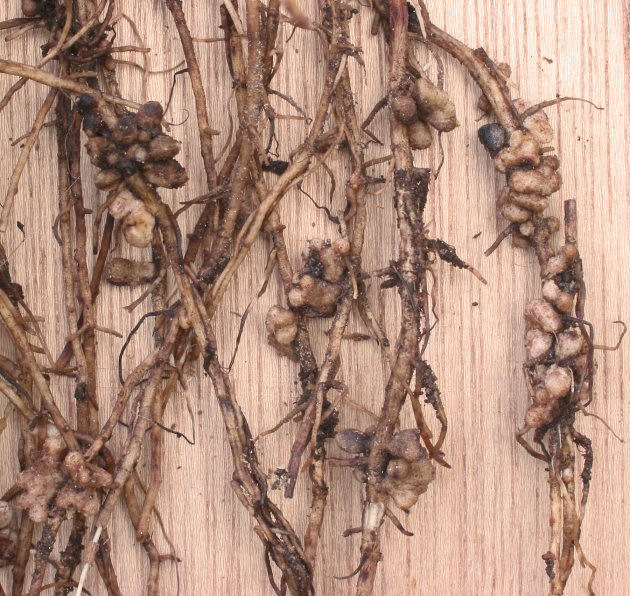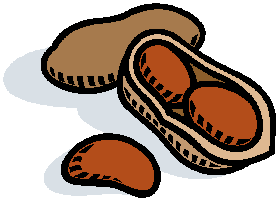
Interactions
The most important interaction the peanut, as well as all
legumes, have is between themselves and the rhizobial bacteria
that inhabit their roots. These bacteria, from the genus Bradyrhizobium,
take on the job of
nitrogen fixation (scroll down link to "Nitrogen Fixation")
for the plant. A supply of nitrogen is vital to plant
and the rhizobial bacteria
that inhabit their roots. These bacteria, from the genus Bradyrhizobium,
take on the job of
nitrogen fixation (scroll down link to "Nitrogen Fixation")
for the plant. A supply of nitrogen is vital to plant life and a
lack of it often inhibits plant growth. Unfortunately, the
nitrogen available from the atmosphere (N2) is an
unusable form due to the extremely strong triple bond between
the two nitrogen atoms. So, to solve that problem, legumes have
formed a mutualistic relationship with the rhizobia. The
rhizobia are provided with a safe place to live and carbohydrates for energy while the peanut
receives usable nitrogen, generally ammonia (NH3). It is
this way of getting nitrogen that allows the peanut to live poor
quality soil with no problem.
life and a
lack of it often inhibits plant growth. Unfortunately, the
nitrogen available from the atmosphere (N2) is an
unusable form due to the extremely strong triple bond between
the two nitrogen atoms. So, to solve that problem, legumes have
formed a mutualistic relationship with the rhizobia. The
rhizobia are provided with a safe place to live and carbohydrates for energy while the peanut
receives usable nitrogen, generally ammonia (NH3). It is
this way of getting nitrogen that allows the peanut to live poor
quality soil with no problem.
 The peanut's rhizobia live in pockets of plant material that grow
from the roots called nodules. But the rhizobia don't just
automatically start there. When the peanut plant is still young, the rhizobia move towards the peanut's roots, there is a moment of
mutual recognition between the rhizobia and plant, and then the
rhizobia begin to colonize on the root surface. Once the rhizobia
have attached themselves, they enter the root by one of
three ways. Which way it happens is determined by the peanut plant.
Typically, they can either enter through the root hairs, which is
the most common way, through an injury, or between undamaged
epidermal cells. In the peanut, the rhizobia send a signal that
cause the hairs at the emerging lateral roots to deform. This causes
the structure of the cell walls to be altered, thus allowing the
rhizobia to enter. Once inside, the rhizobial bacteria begin to
quickly multiply, and the cells that hold the rhizobia repeatedly
divide to create the nodule. Soon, the peanut root possesses its own
personal nitrogen fixing knob.
The peanut's rhizobia live in pockets of plant material that grow
from the roots called nodules. But the rhizobia don't just
automatically start there. When the peanut plant is still young, the rhizobia move towards the peanut's roots, there is a moment of
mutual recognition between the rhizobia and plant, and then the
rhizobia begin to colonize on the root surface. Once the rhizobia
have attached themselves, they enter the root by one of
three ways. Which way it happens is determined by the peanut plant.
Typically, they can either enter through the root hairs, which is
the most common way, through an injury, or between undamaged
epidermal cells. In the peanut, the rhizobia send a signal that
cause the hairs at the emerging lateral roots to deform. This causes
the structure of the cell walls to be altered, thus allowing the
rhizobia to enter. Once inside, the rhizobial bacteria begin to
quickly multiply, and the cells that hold the rhizobia repeatedly
divide to create the nodule. Soon, the peanut root possesses its own
personal nitrogen fixing knob.
Want to learn some more about other legumes
with these rhizobia? Check out these pages:
 Garden
Pea
Garden
Pea
Velvet Bean
Soybean
Alfalfa
Pongam Tree
Although the peanut does have a wonderful relationship with a
bacteria that provides life-giving nitrogen, it is by no means the
perfect plant. It may not have to deal with shortages of nitrogen, but it does have its problems.
These problems arise in the form of pests such as the Heliothis
species of moth, which can cause a lot of damage in large
numbers, and the fungus Thanatephorus cucumeris, which
causes "damping off" of seeds, which means to stop them from
growing. Also, virtually all peanut butter in the United States
contains some amount of alfatoxin, a fungal toxin that is a known
carcinogen, which means it is known to cause cancer. But don't
worry! The Food and Drug Administration (FDA) has regulations in
place that make the amount of aflatoxin in peanut butter far below
fatal, or even noticable, levels.
deal with shortages of nitrogen, but it does have its problems.
These problems arise in the form of pests such as the Heliothis
species of moth, which can cause a lot of damage in large
numbers, and the fungus Thanatephorus cucumeris, which
causes "damping off" of seeds, which means to stop them from
growing. Also, virtually all peanut butter in the United States
contains some amount of alfatoxin, a fungal toxin that is a known
carcinogen, which means it is known to cause cancer. But don't
worry! The Food and Drug Administration (FDA) has regulations in
place that make the amount of aflatoxin in peanut butter far below
fatal, or even noticable, levels.
There is also another organism that the peanut plant has important interactions with. That organism is, of course, humans! As an important food crop and all around versatile plant, most people do have at least some sort of contact with peanuts or peanut products. To learn more about the uses of peanuts, please click on the link below.
What can you use it for? And wasn't George Washington Carver involved somehow?